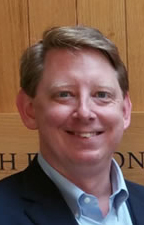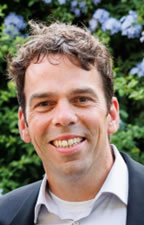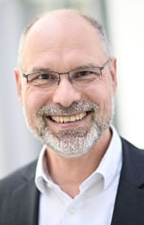
EuRAD Plenary Session Details
Peter Burke, University of California Irvine, CA, US
"Applications of Microwaves from nano to macro: Nano-radar to Drone long range"
Abstract
In this talk I will highlight recent developments in the broad range applications of microwaves and radar from nano to macro. At the nanoscale, antennas can be used to bring microwaves into live cells for real time interrogation of biological structure and function. Just as aircraft are detected long range on radar, it may be possible one day to detect minute cellular structure and organelles inside cells using nano-radar, with applications to medicine and biology. At the other end of the scale is the application of radar and microwaves in drone control and communications. This includes multiple applications such as (near term) search and rescue, aerial communications hubs and platforms, and eventually (long term) integration into the manned aviation airspace. This broad spectrum of new topics shows that the field of microwaves, while already impacting society through enabling of wireless communications, now has new emerging fields of impact in unmanned aerial vehicles and biology. Although Heinrich Hertz and Marconi clearly envisioned the impact of microwaves on society through communications, that has become ubiquitous only in the last few decades, the longer term impact is just getting started in broad, new areas of application. I will highlight the challenges and opportunities in continuing to develop microwave technology for positive societal impact.
 Peter J. Burke (Fellow, IEEE) received the Ph.D. degree in physics from Yale University, New Haven, CT, USA, in 1998. From 1998 to 2001, he was a Sherman Fairchild Postdoctoral Scholar in physics with the California Institute of Technology, Pasadena, CA, USA. Since 2001, he has been a Faculty Member with the Department of Electrical Engineering and Computer Science, University of California at Irvine, Irvine, CA, USA. His research has led to multiple startup companies in the RF and biotech area, as well as numerous awards such as the Army Young Investigator Award, Navy Young Investigator Award, Dean’s Award for Faculty Innovation in Teaching (Spring 2022), and a Guinness World Record (2023) for "the farthest distance to control a commercially available Unmanned Aerial Vehicle (UAV) at 18,411 kilometers (11,440 miles).”". His current research interest includes electrophysiology of mitochondria, nano-scale probes of cellular biology (optical, RF, and quantum), ion channel electrophysiology with nanowire sensors, unmanned aerial vehicles (drones), and wireless signal propagation models and measurements.
Peter J. Burke (Fellow, IEEE) received the Ph.D. degree in physics from Yale University, New Haven, CT, USA, in 1998. From 1998 to 2001, he was a Sherman Fairchild Postdoctoral Scholar in physics with the California Institute of Technology, Pasadena, CA, USA. Since 2001, he has been a Faculty Member with the Department of Electrical Engineering and Computer Science, University of California at Irvine, Irvine, CA, USA. His research has led to multiple startup companies in the RF and biotech area, as well as numerous awards such as the Army Young Investigator Award, Navy Young Investigator Award, Dean’s Award for Faculty Innovation in Teaching (Spring 2022), and a Guinness World Record (2023) for "the farthest distance to control a commercially available Unmanned Aerial Vehicle (UAV) at 18,411 kilometers (11,440 miles).”". His current research interest includes electrophysiology of mitochondria, nano-scale probes of cellular biology (optical, RF, and quantum), ion channel electrophysiology with nanowire sensors, unmanned aerial vehicles (drones), and wireless signal propagation models and measurements.
Bjorn Rommen, European Space Agency (ESA), Noordwijk, The Netherlands
"Synthetic aperture radar (SAR) missions in development at the European Space Agency (ESA): overview, status and applications"
 Björn Rommen received the M.S. degree in electrical engineering from the Delft University of Technology, Delft, The Netherlands, in 1999. Since then, he has been working in the field of Earth observation at the Research and Technology Centre, European Space Agency (ESA), Noordwijk, The Netherlands. He is currently a Mission Scientist for ESA’s Earth Explorer 7 Biomass and Earth Explorer 10 Harmony missions. His research interests include a wide range within the domain of active microwave remote sensing—involving work at both microwave instrument conceptual level and leading research and development (R&D) activities investigating wave interaction with the Earth’s surface (including bio/geophysical parameter retrieval) and atmosphere—which, for a large extent, has been driven by synthetic aperture radar (SAR) missions in preparation at ESA. He has been involved in the Sentinel-1A and −1B prelaunch and postlaunch activities, including the commissioning phases covering overall SAR in-orbit performance and system calibration activities. His research interests also include electromagnetics theory, computational electromagnetics, and radar remote sensing.
Björn Rommen received the M.S. degree in electrical engineering from the Delft University of Technology, Delft, The Netherlands, in 1999. Since then, he has been working in the field of Earth observation at the Research and Technology Centre, European Space Agency (ESA), Noordwijk, The Netherlands. He is currently a Mission Scientist for ESA’s Earth Explorer 7 Biomass and Earth Explorer 10 Harmony missions. His research interests include a wide range within the domain of active microwave remote sensing—involving work at both microwave instrument conceptual level and leading research and development (R&D) activities investigating wave interaction with the Earth’s surface (including bio/geophysical parameter retrieval) and atmosphere—which, for a large extent, has been driven by synthetic aperture radar (SAR) missions in preparation at ESA. He has been involved in the Sentinel-1A and −1B prelaunch and postlaunch activities, including the commissioning phases covering overall SAR in-orbit performance and system calibration activities. His research interests also include electromagnetics theory, computational electromagnetics, and radar remote sensing.
Joachim Mathes, Valeo
"Why SDV is more than a buzzword"
Abstract:
Everybody talks about the software-defined vehicle these days. What does it actually mean for the way that vehicles will be designed in the future, how will the E/E architecture change and what solutions will be required to make this commercially viable?
We will look into the market environment and how this will evolve over the next few years. Based on this, some concrete examples will illustrate how in particular ADAS and AD systems with their high computational loads can be designed to meet the performance requirements and scalability needs for future software-defined vehicles.
This goes beyond the individual vehicle, but needs to consider data collected from an entire fleet of vehicles to analyze and understand corner cases, to improve robustness and to enable new features and services for the end user. This, in turn requires a software architecture and data pipeline to support these ambitions, and it means that the hardware offers the headroom to provide the necessary performance even after the first launch. Not all of this is new, but so far a lot of it has remained theoretical or has only been partially implemented. To go the full length, requires some paradigm changes. Valeo has a few answers to propose.
 Joachim Mathes started his career at SWF in Bietigheim in 1989 after graduating inelectronic engineering from BA Stuttgart. He contributed to the development of ultrasonic systems and first generation ADAS systems. Following the acquisition byValeo, he was nominated Project Management Director. In 2001, Valeo created a Branch for Switches and Detection Systems, where Joachim was appointed Director for R&D and Product Marketing. He strengthened Valeo’s technology portfolio through a number of partnerships and laid the foundation for Park4U. He led the creation of development centers in several regions.
Joachim Mathes started his career at SWF in Bietigheim in 1989 after graduating inelectronic engineering from BA Stuttgart. He contributed to the development of ultrasonic systems and first generation ADAS systems. Following the acquisition byValeo, he was nominated Project Management Director. In 2001, Valeo created a Branch for Switches and Detection Systems, where Joachim was appointed Director for R&D and Product Marketing. He strengthened Valeo’s technology portfolio through a number of partnerships and laid the foundation for Park4U. He led the creation of development centers in several regions.
As R&D Director of the CDA Business Group, which was established in 2010, he initiated Cruise4U and Drive4U programs, the SCALA laser scanner and further extended the R&D footprint, including the creation of a dedicated software organization.
In July 2019 Joachim was nominated CTO for Comfort and Driving Assistance Systems.
Advertisement
About EuMA
 The European Microwave Association (EuMA) is an international non-profit association with a scientific, educational and technical purpose. The aim of the Association is to develop in an interdisciplinary way, education, training and research activities. [more]
The European Microwave Association (EuMA) is an international non-profit association with a scientific, educational and technical purpose. The aim of the Association is to develop in an interdisciplinary way, education, training and research activities. [more]
EuMW Downloads
- Download the 2024 call for papers in PDF format
Future & Past Events
News and Press
- Keynote Speakers of the EuRAD Plenary Sessions Announced





